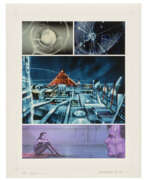Futurism

Futurism
Futurism was an Italian art movement, born out of a 1909 manifesto by the poet Filippo Tommaso Marinetti. It celebrated speed, technology, youth, and violence, embracing the energy of modern life. This avant-garde movement extended beyond painting to influence literature, architecture, and even fashion, reflecting a fascination with the dynamism of contemporary existence.
Characterized by a visceral rejection of the past, Futurists like Umberto Boccioni, Carlo Carrà, and Giacomo Balla wanted to eradicate traditional values in favor of a new, technologically triumphant world. They sought to capture motion and the essence of the industrial city, often using vibrant colors and techniques that conveyed movement and transformation, aiming to involve the viewer in the artwork's rhythm.
Museums around the globe, including the Museum of Modern Art in New York and the Baltimore Museum of Art, house significant Futurist works. These works display the movement's unique aesthetic, which embraced "Universal Dynamism," asserting that all objects are interconnected, dismissing the separation between the subject and the environment.
For enthusiasts, collectors, and experts, Futurism represents a seminal phase in modern art, linking technological progress with cultural expression. If you're interested in exploring or acquiring works of this influential movement, signing up for updates on new sales and auction events is recommended. This subscription service focuses on keeping you informed about opportunities related to Futurist art, ensuring you're always at the forefront of this dynamic market.
| Country: | Europe, Italy, Russia |
|---|---|
| Start of the period: | 1909 |







